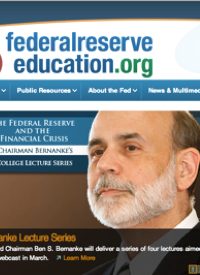
As the Federal Reserve came under increasing scrutiny by outraged lawmakers and the public in recent years, it hired a lobbyist to defend its controversial secrecy and produced propaganda-filled comic books aimed at young children. It even sought to develop a tool to spy on concerned citizens over the Internet.
Now, as the anti-Fed outcry continues to grow, the embattled central bank has another dubious public-relations ploy in the works: reaching out to high-school students. As part of the new scheme, functionaries at the St. Louis Fed branch recently developed a curriculum for what they call an “economic education.”
The course, posted online at a Fed-run “education” website, is designed to convince young Americans of the controversial institution’s supposed necessity and its alleged constitutionality. Of course, the lesson plan makes no mention of the fact that the privately owned Fed is actually nothing more than a banking cartel — let alone that all of the fiat currency it creates is issued as debt with impossible-to-pay interest attached.
Critics promptly lambasted the idea. “It now appears that the propaganda masters at the Office of Central Planning have decided to go for young American minds while they are still pliable,” noted a recent article about the new scheme on the financial analysis site ZeroHedge. The piece, entitled “Fed to Take Propaganda to the Schoolroom: Will Teach Grade 8-12 Students about Constitutionality Of… The Fed,” blasted the curriculum as an effort to fill the minds of children with “dogmatic propaganda.”
“It appears that as part of its reenactment of Goebbels ‘economic education’ curriculum, the Fed will now directly appeal to 8-12 grade students, in which it will elucidate on the premise of ‘Constitutionality of a Central Bank,’” the blistering report observed, adding, “You know — just in case said young (and soon to be very unemployed) minds get ideas that heaven forbid, the master bank running the US is not exactly constitutional.”
The lesson plan instructs teachers to rely on the nearly 200-year-old Supreme Court case McCulloch v. Maryland. The dubious ruling struck down a state tax on an early version of the American central bank while purporting to extend “implied” powers to Congress that were not specifically mentioned in the Constitution.
Because of that “precedent,” the course argues, the federal government has the constitutional authority to delegate its authority to “coin money” to the cartel of private banks known as the Fed. And, while not saying so explicitly, the lesson claims that Congress has the authority to allow the Fed to produce debt-based paper currency as opposed to “money.”
The Constitution specifies that no state shall make anything other than gold or silver into currency, too. But that minor detail is completely overlooked in the lesson as well.
The Fed’s curriculum also compares the effect of the ruling two centuries ago to parents setting a “precedent” by extending their children’s curfew. “Share the following example with students: In a discussion with your parents concerning your curfew this Friday night, you might make an argument for a later curfew. Your parents might deliberate and finally make a decision — that your curfew this Friday will be midnight,” the lesson states. “That decision might serve as a precedent for your curfew on future Friday nights.”
Later on in the controversial lesson, students are expected to apply the Fed’s faulty reasoning and justify the purported constitutionality of the Fed. “The Federal Reserve is the central bank of the United States. The Constitution does not specifically say that there should be a central bank,” it observes. “Describe how you might defend Congress’ delegation of the power to coin money and regulate the value of money to the Federal Reserve.”
The Fed’s lesson also makes a series of wildly inaccurate statements intended to convince students that the Fed is both helpful and necessary. “Explain that for a long time [after the second American central bank was shut down], the United States did not have a central bank, and the U.S. economy experienced many financial panics and economic problems as a result,” it falsely alleged, carefully omitting the fact that the biggest financial panic and economic problem — the Great Depression — was directly attributable to the Fed’s policies.
To its credit, the course outline does explain the dangers of printing too much money, even offering Zimbabwe’s wild hyperinflation as an example of what can happen. It also explains that the Fed’s currency is backed by nothing but the power of official coercion.
“Money used by the United States, and other modern economies, is called fiat money because it is not backed by gold or other valuable commodities,” it admits. “The value of fiat money comes from being endorsed by the government and it has exchange value.”
However, the Fed also instructs teachers to offer students a highly controversial — many economists would even say inaccurate — definition of inflation. “Explain that the inflation rate is the percent change in the price level of goods and services from one time period to another,” the curriculum demands. “Define inflation as a general, sustained upward movement of prices for goods and services in the economy.”
It then proceeds to define “price stability” — one of the Fed’s missions as defined by Congress — as “low and stable inflation.” Incredibly, the Fed also manages to get the relationship between true inflation — an expansion of the currency supply — and price increases entirely wrong. “Inflation is an increase in the overall price level that reduces the value of money,” it falsely claims.
In another section, however, it offers a more truthful version. “In the long run, inflation results from increases in a nation’s money supply that exceeds increases in its output of goods and services,” the course plan tells teachers.
But then, it makes a complete mockery of the truth, absurdly claiming that the Fed “regulates the value of money by making sure that the growth of the money supply does not exceed the ability of the economy to produce goods and services.” In reality, of course, Federal Reserve Notes (known as “dollars”) have lost more than 95 percent of their value since the central bank was created in 1913.
Beyond misleading students on the Fed and inflation, the course also offers an extraordinarily deceptive view of the Constitution and the powers it allegedly grants to Congress. It claims in the "answer key," for example, that the power to lay and collect taxes implies that the federal government can constitutionally “use tax revenues to fund public schools, health, and housing programs” and “require states to meet certain conditions to qualify for federal funding.”
Then there is the power to “regulate commerce.” The Fed’s lesson claims the authority — originally granted to prevent protectionism and trade barriers among the states — allows Congress to regulate banking, establish a minimum wage, ban “discrimination in workplaces and public facilities,” pass laws “protecting the disabled,” and more. Essentially, according to the view presented in the Fed’s lesson plan at least, the “elastic” clause of the Constitution allows government to do virtually anything.
“The old Soviet Union, as well as 1930s Nazi Germany, understood the importance of indoctrinating the younger generations into the ideologies of the ruling party's policies and doctrines to ensure the future of their cause,” noted Kenneth Schortgen, Jr. with the Finance Examiner in an article about the Fed’s latest PR ploy. “That basis for focusing on education has now been grasped by the Federal Reserve.”
One glaring omission in the Fed’s “economic education” plans, Schortgen pointed out, is the vehement opposition to the central bank by many of America’s Founding Fathers, Presidents, and top financiers throughout history. Thomas Jefferson and Andrew Jackson, for example, were famous for their opposition to central banking. And countless experts throughout American history have argued that the Constitution prohibits the creation of such institutions.
“As the education system in America becomes more of a breeding ground for social changes, the Federal Reserve appears to be jumping on board with an education plan of its own to counter and indoctrinate young students on its importance in controlling monetary policy for the nation,” Schortgen wrote. “Since its inception, the central bank has struggled to fight against the words of dead Presidents and historical figures on the evils of its mechanisms, but now it has found a ripe audience in an education system that in many cases, is throwing away old teachings and paradigms and embracing new ones.”
As pressure on the Fed and its debt-based fiat currency continues to build, analysts expect more and more propaganda gimmicks to emerge defending the monetary status quo. But judging by the growing tsunami of outrage over the cartel’s multi-trillion-dollar bank bailouts, its widespread manipulation of markets, and the accelerating decline of the currency's value, it may be too late.
Related articles:
Fed Plotting to Monitor Critics, Tailor Propaganda
Federal Reserve Hiring Lobbyist for Political War
Comic Books From the Federal Reserve
Federal Reserve Has Become a Focal Point of Public Anger
The Fed: Defending the Indefensible
Fed Chairman Bernanke Is on the Defensive
Bernanke: Fed Could "Step Into New Areas"
Fed Manipulations in the Crosshairs
U.S. Fed Bailout of Euro Prompts New Push for Audit & Sound Money



